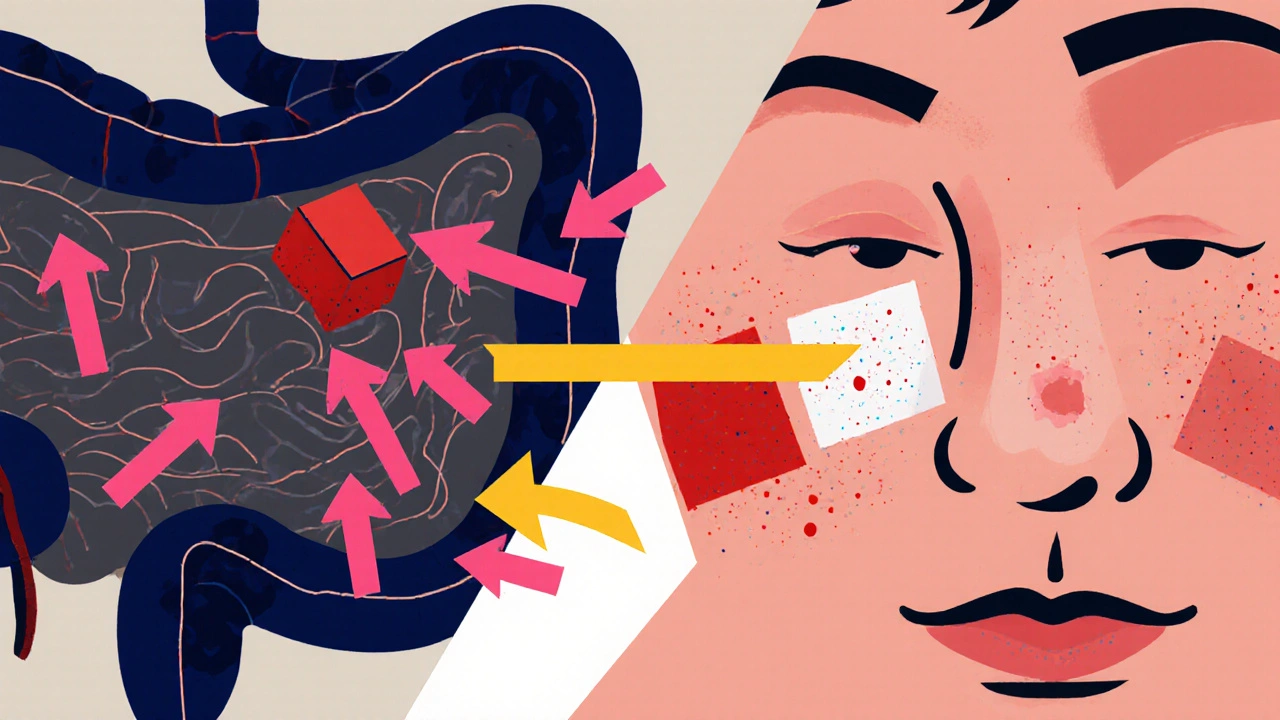Gut-Skin Connection Assessment
This assessment helps identify which gut-skin connections may be most relevant to you based on your habits and skin concerns. Answer the questions below to get personalized recommendations.
Ever wonder why a flare‑up on your face sometimes feels linked to what you ate? The science behind the gut‑skin connection is finally catching up with everyday experience. Below you’ll get the low‑down on the gut microbiome, the skin conditions it can influence, and what the newest studies actually say.
What the Gut Microbiome Is and Why It Matters
Gut microbiome is the community of trillions of bacteria, fungi and viruses that live in your digestive tract. It helps break down food, produce vitamins, train the immune system and keep harmful microbes in check. When the balance shifts - a state called dysbiosis - you may notice more than just stomach aches.
Common Skin Conditions Tied to the Gut
Not every rash is caused by a gut issue, but several chronic skin problems show a surprisingly strong link.
- Acne a blockage of hair follicles often driven by inflammation and bacterial overgrowth
- Eczema (atopic dermatitis) a itchy, inflammatory skin condition that flares with immune triggers
- Psoriasis an autoimmune-driven scaling disorder that responds to systemic inflammation
- Rosacea facial redness that can worsen with gut‑derived inflammatory signals
How the Gut Talks to Your Skin
The gut‑skin axis works through several overlapping pathways:
- Inflammation: When the gut barrier leaks (often called "leaky gut"), bacterial fragments called lipopolysaccharides enter the bloodstream, sparking systemic inflammation. Inflammation a core driver of acne lesions, eczema flare‑ups and psoriasis plaques.
- Immune modulation: The gut trains T‑cells and other immune players. An over‑active or mis‑directed immune response can attack skin cells, especially in autoimmune conditions like psoriasis. Immune system coordinates defense and tolerance, heavily influenced by gut microbes.
- Metabolite production: Friendly bacteria churn out short‑chain fatty acids (SCFAs) such as butyrate, which reinforce the gut lining and have anti‑inflammatory effects on the skin. Short-chain fatty acids organic acids that support barrier function and reduce skin inflammation.
- Hormonal signaling: Gut microbes help regulate hormones like cortisol and insulin, both of which can aggravate acne and other skin issues.

Key Research Findings (2020‑2025)
Scientists have moved from anecdotal reports to controlled studies. Here are the most compelling results.
- Probiotic trials for acne: A 2022 double‑blind trial gave participants Probiotics live beneficial bacteria taken orally or topically containing Lactobacillus rhamnosus and Bifidobacterium longum for 12 weeks. Researchers observed a 30% reduction in inflammatory lesions compared with placebo.
- Gut dysbiosis in eczema infants: A 2021 cohort of 500 babies showed that low diversity of Bifidobacterium species in the first six months correlated with a 2.5‑fold higher risk of developing atopic dermatitis by age two.
- SCFA levels and psoriasis severity: A 2023 cross‑sectional study measured serum butyrate and found an inverse relationship with PASI scores (a standard psoriasis severity index). Higher butyrate meant milder disease.
- Dietary patterns: Mediterranean‑style diets, rich in fiber, nuts and olive oil, boosted gut microbial diversity and led to measurable improvements in rosacea severity in a 2024 pilot study.
Practical Steps to Support Both Gut and Skin
Below is a checklist you can start today. Each point is backed by at least one of the studies above.
- Eat diverse fiber: Aim for 25-30 g daily from vegetables, legumes, whole grains and fruit. Fiber feeds SCFA‑producing bacteria.
- Include fermented foods: Yogurt, kefir, sauerkraut, kimchi and kombucha add live Probiotics to your diet.
- Consider a targeted probiotic supplement: Choose strains shown to help skin, such as Lactobacillus rhamnosus GG, Bifidobacterium breve, or the multi‑strain blends used in the 2022 acne trial.
- Limit processed sugar and refined carbs: High glycemic foods can trigger insulin spikes, worsening acne and gut dysbiosis.
- Stay hydrated: Water supports mucosal layers in the gut, reducing permeability.
- Reduce unnecessary antibiotics: Broad‑spectrum antibiotics wipe out beneficial microbes, often leading to dysbiosis and subsequent skin flare‑ups.
- Manage stress: Chronic stress elevates cortisol, which can increase gut permeability and skin inflammation.
Common Myths Debunked
1. "Only topical creams fix skin problems" - While moisturizers help symptoms, they don’t address the systemic inflammation that often starts in the gut.
2. "All probiotics are the same" - Strain specificity matters. The Lactobacillus rhamnosus strain that helped acne is not interchangeable with Lactobacillus acidophilus used for digestive upset.
3. "You can cure eczema with diet alone" - Diet can dramatically reduce flare frequency, but many patients still need moisturizers or prescription therapy for acute episodes.
Quick Reference Table
| Skin Condition | Gut Link Strength | Key Microbial Players | Suggested Gut‑Focused Intervention |
|---|---|---|---|
| Acne | Moderate | Low Lactobacillus, high Propionibacterium | Oral probiotic with Lactobacillus rhamnosus; high‑fiber diet |
| Eczema | Strong | Reduced Bifidobacterium diversity | Early‑life probiotic (B. infantis); avoid early antibiotics |
| Psoriasis | Moderate | Low SCFA‑producing Faecalibacterium | SCFA‑boosting diet; probiotic with Bifidobacterium longum |
| Rosacea | Emerging | Imbalanced Firmicutes/Bacteroidetes ratio | Mediterranean diet; fermented foods; stress reduction |
Next Steps & Troubleshooting
If you’ve started the checklist and still see stubborn breakouts, try these tweaks.
- Re‑evaluate antibiotics: Ask your doctor if a narrower‑spectrum drug could replace a broad‑spectrum prescription.
- Test for SIBO (small intestinal bacterial overgrowth): Excessive bacteria in the upper gut can cause bloating, which sometimes mirrors skin flare‑ups.
- Consider a stool analysis: Labs can identify specific deficiencies (e.g., low Bifidobacterium) and guide personalized probiotic selection.
Frequently Asked Questions
Can a probiotic really improve acne?
Yes. Clinical trials from 2021‑2023 show that multi‑strain probiotics featuring Lactobacillus rhamnosus can cut inflammatory lesions by about a third when taken for 12 weeks alongside a low‑glycemic diet.
Is it safe to take probiotics with prescription skin meds?
Generally, yes. Probiotics act locally in the gut and don’t interfere with topical retinoids or oral antibiotics for skin. If you’re on systemic immunosuppressants, check with your physician.
How long does it take to see skin benefits after changing my diet?
Most people notice a difference in 4‑8 weeks, because gut microbial shifts and SCFA production need time to stabilize.
Do all fermented foods contain the same probiotic strains?
No. The strains vary by fermentation method and starter culture. For skin‑focused benefits, look for products that list Lactobacillus rhamnosus, Bifidobacterium breve, or Saccharomyces boulardii on the label.
Can stress alone trigger a gut‑skin flare?
Stress elevates cortisol, which can increase gut permeability and promote inflammation. A 2022 study linked high perceived stress scores to higher acne counts, independent of diet.
Bottom line: gut health isn’t just about digestion - it’s a central player in how your skin looks and feels. By feeding the right microbes, limiting inflammation and keeping the gut barrier sealed, you give your skin the best chance to stay clear and calm.






Apparently the food industry is in on the whole gut‑skin secrecy, feeding us processed junk while they hide the real cure. It’s no wonder our faces act up when the boardroom decides what’s on the shelf.
October 20Matthew Hall